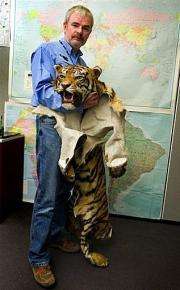Smuggling wildlife: From eggs in a bra to geckos in underwear

John Sellar is no comic book super hero, but judging by the criminals he deals with as the only policeman at the UN agency against illegal wildlife trade, he could well be one.
Russian mafia, Latin American druglords, suspected rebel or terror groups and crooked Asian diplomats count among poachers of rhinoceros, tigers and leopards whom Sellar aims to collar.
"My title is chief, but I have no Indians," he told AFP.
A former policeman in Scotland, he is the "enforcement assistance chief" at the UN agency against illegal wildlife trade, the Convention on International Trade in Endangered Species of Wild Fauna and Flora (CITES).
With a budget of 5.1 million dollars this year, its resources are so strapped that the organisation does not even have a data base of known criminal activities in illegal trafficking of animal parts.
Sellar's space is confined to a small office that fits in only an L-shaped desk, three chairs and a row of bookshelves, where he coordinates enforcement activities undertaken by local customs authorities or police.
However, in many of the poorer countries where poaching occurs, enforcement teams "don't even have access to forensic science for murder, so they're not going to have resources for rhinos," he said.
Behind the scenes, meanwhile, organised crime appears to be tightening its grip on the illegal trade, attracted by its high returns, according to evidence collected by CITES and non-governmental organisations.
The Russian mafia has been found to be involved in illicit caviar trade, while some Asian gangs have been caught trafficking rhino horns, which are promoted for medical uses, and elephant ivory, so prized in Asian art.
Sellar is reluctant to estimate the value of the illicit commerce, but said the high value could be driving more people to try their luck in the trade.
Major conservation groups including the Worldwide Fund for Nature said in a report last month that demand for rhinoceros horns in Asia has driven rhinoceros poaching to a 15-year-high.
A rhino horn is easily worth "several tens of thousands of dollars per kilo," he noted. "In weight, rhino horn is much more profitable than gold or diamonds or heroin or cocaine. You're getting much more returns."
Some criminals are also attracted by the prospect of laundering other ill-gotten gains, added Sellar.
"The money associated with narcotics, human trafficking is huge. They have so much money they don't know what to do with it. They can't wash it fast enough," said Sellar.
"They've obviously been looking into areas where they can get into -- ivory is one, caviar trade is another.
In addition, gangs having trouble carrying wads of cash or stashes of diamonds around the world are simply converting them into rhino horns or other exotic animal parts.
"Financial crime units have tended historically to focus on particular forms of avoidance. They're not looking for a rhino horn or caviar. It's an evasion on the part of organised crime," he said.
Bit wildlife crime is "not regarded as mainstream crime" and as a result, little priority is given to cracking down on the trade, said Sellar, who sees this as a wasted opportunity.
He cited the example of Al Capone, the notorious Chicago gangster who was arrested not for his heinous crimes but for not declaring his taxes.
"I think sometimes by failing to address wildlife crime, some agencies are missing the opportunity to deal with these organised criminals," Sellar said.
"A lot of these criminal networks are probably not covering their tracks as carefully when they're dealing with illegal wildlife trade as they might do when dealing with human trafficking or narcotics.
"There are lots of opportunities for us to arrest these people," he insisted.
Even rebel or terror groups have turned to poaching to fund activities, particularly in Africa, Sellar said. "If you look in parts of Africa, then poaching there has funded rebel activities for decades."
Beyond the shady gangs, suit-wearing diplomats have been caught red-handed.
Sellar would not name specific countries, but said "it is probably true to say that it's more often than not Asian diplomats. Not exclusively, but that appears to be the trend."
In November, Vietnam said it would recall one of its diplomats from South Africa after she was filmed conducting an illegal deal for protected rhinoceros horn.
This "by no means whatsoever" is the only instance of diplomatic involvement in the trafficking, according to Sellar who said growing affluence in Asian countries such as Vietnam and China seems to be fueling the demand.
He cited another example in an east African country he would not name where an Asian diplomat sought to use his legal immunity to smuggle elephant tusks through customs in metal boxes marked as diplomatic bags.
"The diplomat was arrested but subsequently bailed by his country and fled," said Sellar.
"Diplomatic immunity is regrettably abused, not regularly, but it is not uncommon for us to see people abusing immunity," he said.
"They use cars with CD plates, they use diplomatic baggage, parcels... to smuggle ivory, rhino horns, basically you name it."
(c) 2009 AFP















